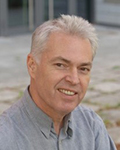This event took place on Sept. 22, 2016 and is no longer available on-demand.
An explosion of recent work has revealed that the glial cells of the central nervous system, so often ignored, actually play many essential roles, far beyond the simple “nutritive” and “support” roles initially hypothesized.
In this virtual conference, experts in the biology of astrocytes, oligodendrocytes, and microglia will share new insights into glial cells as key players in nervous system function. These insights come from work in a variety of animal species, ranging from fruit flies to humans.
Topics to be covered include gliotransmission, large-scale excitation of astrocytes, roles for astrocytes and microglia in synaptic pruning, glial roles in energy metabolism and homeostasis, activity-dependent remodeling of myelin by oligodendrocytes, and distinct features of human astrocytes that may contribute to advanced cognitive functions.
Click on each session title to reveal its description.
Session 1: The Concept of Glia – From Glue to Clever
Speakers: Helmut Kettenmann
Time: 9:10 a.m. – 9:40 a.m. EDT
Kettenman will begin the conference with a brief historical perspective on glial cells in the central nervous system. He will describe early ideas about the functions of astrocytes, oligodendrocytes, and microglia, and then provide a glimpse into modern research that indicates that glia perform many more roles than ever imagined and are essential players in most neural functions.
Session 2: Oligodendrocyte and Myelin Plasticity in Information Processing and Learning
Speakers: Doug Fields
Time: 9:45 a.m. – 10:25 a.m. EDT
Fields will discuss recent ground-breaking experiments that reveal that oligodendrocytes, the cells that make myelin in the brain and spinal cord, have plastic properties even in adulthood. His group’s findings reveal that, as activity in neural circuits changes, oligodendrocytes vary the thickness of myelin sheathes, leading to changes in the conduction velocity of action potentials — in other words, they are constantly tuning the connections between neurons not at the synapse, but along the length of the axon. Fields will show that myelin plasticity plays a part in information processing and learning. Fields’ presentation will be followed by a short question-and-answer session.
Session 3: New Insights Into Astrocytes – Functional Dynamics, Diversity, and Specialization
Speakers: Lynne Oland, Don van Meyel, Jeff Rothstein, Maiken Nedergaard
Time: 10:35 a.m. – 12:35 p.m. EDT
Oland will moderate a lively interactive panel discussion focused on recent insights into the development, distribution, activity, and impact of astrocytes. The major theme will be to elucidate many of the critical roles played by astrocytes in modulating synaptic function.
Van Meyel will describe the development and organization of astrocytes in the fruit fly Drosophila melanogaster, which offers powerful molecular genetic tools for cellular and behavioral analyses. He will describe his group’s insights into the fundamental properties of astrocytes in the fruit fly, including their critical role in glutamate uptake at synapses. He will also describe how his lab has shown this model to be useful in exploring a new pathophysiological mechanism stemming from astrocyte dysfunction in humans with episodic ataxia.
Rothstein will share his group’s recent work showing that astrocytes in the cerebral cortex of mice are molecularly differentiated at the level of individual cortical layers. He will describe experiments aimed at understanding how this unexpected discovery opens the door to a detailed understanding of the role of neuron-astrocyte interactions in modulating neuronal transmission, synaptic biology, as well as layer specific modulation of astroglia. As a practicing neurologist, he will also discuss implications for normal function and for particular neurological disorders.
Nedergaard will discuss experiments in which glial progenitor cells from humans were engrafted into mouse brains, yielding mice whose brains were populated by human astrocytes. The presence of human astrocytes led to enhanced synaptic plasticity and learning. Nedergaard will discuss mechanisms underlying this striking finding and the emerging notion that the evolution of human cognition must be in part tied to the evolution of astrocytes.
Session 4: Large-Scale Recording of Astrocyte Activity
Speakers: Axel Nimmerjahn
Time: 12:50 p.m. – 1:25 p.m. EDT
Nimmerjahn will describe new microscopy approaches that have allowed his group to record calcium activity in large networks of astrocytes in brain and spinal cord of behaving mice. He will discuss how various forms of astrocyte calcium excitation relate to neuronal activity, how they differ between brain and spinal cord, and how they might influence neural circuits and behavior. He will also discuss current technological challenges in studying astrocyte function in vivo. Nimmerjahn’s presentation will be followed by a short question-and-answer session.
Session 5: How Microglia Prune Synapses in Health and Disease
Speakers: Beth Stevens, Soyon Hong
Time: 1:30 p.m. – 2:10 p.m. EDT
Stevens will discuss an unexpected role for microglia, the immune cells of the CNS, in shaping synaptic networks. She will focus on cellular and molecular mechanisms underlying experience-dependent pruning of synapses. Her group’s work has revealed that microglia and certain innate immune proteins are essential players in the fine-tuning of synaptic circuits during normal development, and opens up the possibility of novel mechanisms by which synapses may be eliminated in disease. Soyon Hong, a postdoc in Stevens’ lab, will take live questions after Stevens’ presentation.
Session 6: New Tools – Molecular Genetic Approaches to Studying Neuron-Glia Interactions in Development and Following Injury
Speakers: Marc Freeman
Time: 2:20 p.m. – 2:50 p.m. EDT
In an interactive meet-the-expert session, Freeman will make a short presentation before engaging with the audience for a robust question-and-answer session. The content of the discussion will relate to Freeman’s work in Drosophila and how the use of this species allows his group to probe controlling roles for astrocytes in many aspects of neural circuit formation, function, and recovery from injury. During the discussion, attendees will have a chance to ask questions such as, “What kind of experiments can you do in fruit flies that can't be done anywhere else?”
Session 7: Glia and the Pathophysiology of White Matter Ischemic Injury
Speakers: Bruce Ransom
Time: 2:55 p.m. – 3:25 p.m. EDT
As a practicing neurologist and researcher, Ransom will make the overarching point that a detailed understanding of glial cells is absolutely essential to understanding how our brains work in health and fail in disease. He will outline roles of astrocytes in homeostasis and discuss his group's work on key roles of astrocytes and oligodendrocytes in the pathophysiology of CNS white matter ischemic injury. These studies emphasize the clinical importance of CSN axonal pathways and the unique features of how these pathways, and their glial cells, are damaged by stroke-like conditions. Ransom’s presentation will be followed by a short question-and-answer session.
Session 8: Wrapping It All Up – What New Concepts Are Emerging, and What Are Some Exciting New Directions for Research
Time: 3:30 p.m. – 3:55 p.m. EDT
Ashley McDonough - Postdoctoral Researcher, University of Washington
Christina Welsh - PhD Student, Boston Children's Hospital
Dipankar Dutta - Postdoctoral Researcher, National Institutes of Health, NICHD
Emilie Peco - Research Associate, McGill University
Kohei Sekiguchi - PhD Student, Salk Institute
Lasse Dissing-Olesen - Postdoctoral Research Fellow, Boston Children's Hospital
Soyon Hong - Postdoctoral Research Fellow, Boston Children's Hospital
Susanne Wolf - Senior Research Associate, Max Delbrück Center for Molecular Medicine

















